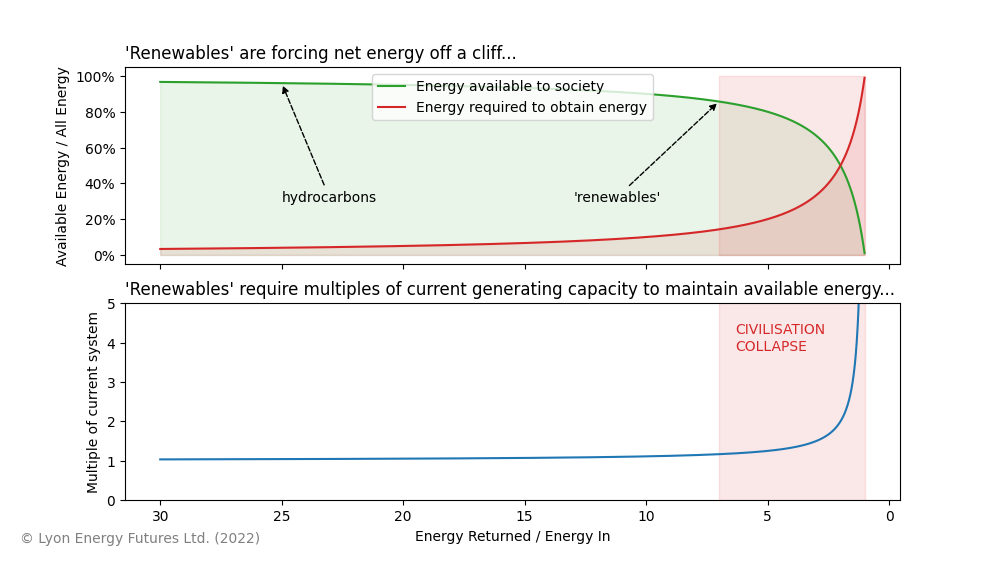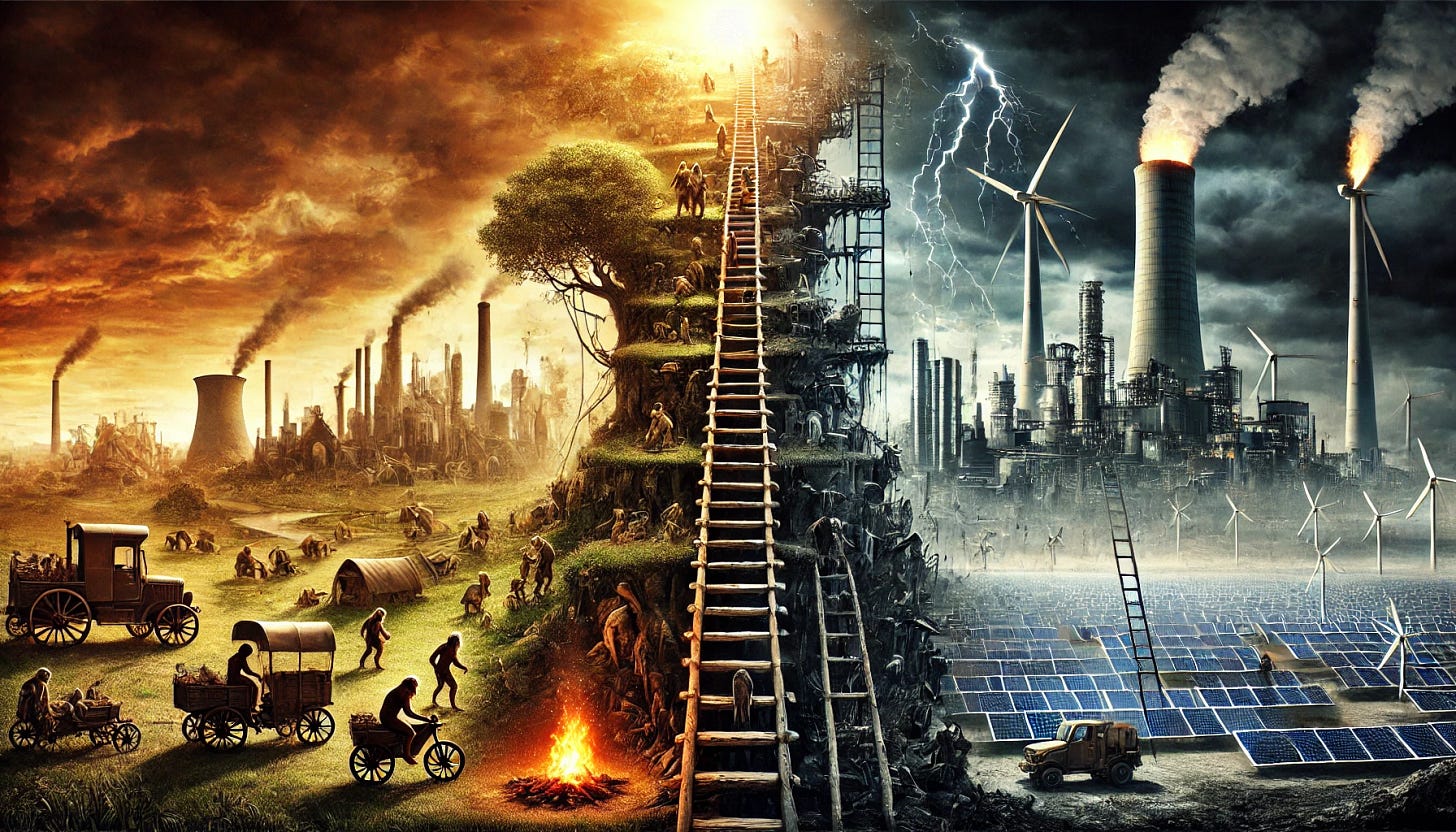THE PREVAILING NARRATIVE in Net Zero ideology is one of a seamless “clean energy transition”. The reality is that their supposedly necessary transition is unlike any in human history because it represents a move down the energy density ladder. Properly understood, the proposal is terrifying.
It’s terrifying because it violates the “Iron Law Of Energy Transition”: successful civilisations always move up the energy ladder toward more concentrated, more reliable power sources. Every historical example of a move down the energy density ladder has been involuntary. And every move down the energy density ladder has produced a mass casualty event.
In a previous essay, we examined the Physics of Net Zero. In this week’s essay, we’ll shift attention to the Physics of Civilisation itself. We’ll look at energy quality, why civilisations require an upward trend in energy quality, and why those that fail to maintain an upward trend in it collapse. Finally, we’ll critique the current proposal.
Let's begin by looking at the Industrial Revolution. It was a transition from wood to coal. Why was this successful? Because of energy density. Coal packs far more energy per kilogram than wood, delivering concentrated power where and when it is needed and removing the need for vast forests near every industrial site, allowing for centralised factories and steam engines.
This leads us to the first pillar of the Iron Law...
Energy density: The Storage Question
Energy density measures how much energy can be stored in a given amount of material or space. Fossil fuels contain about 44 megajoules per kilogram, while the best commercially available batteries manage about 1 megajoule per kilogram. This ~40:1 ratio explains why a combustion engine vehicle’s fuel tank can carry weeks of driving energy, but an electric vehicle requires massive battery packs for much shorter ranges.1
For industrial civilisations like ours, energy density determines how much energy we can stockpile, transport, and deploy as needed. Coal yards and oil reserves contain colossal quantities of energy—enough to power industrial processes continuously for months or years. This creates an inexpensive buffer that allows us to endure disruptions, seasonal variations, and demand variations with ease. The “clean energy transition” has no technology—now, or in prospect—for replicating this capability at civilisation scale.
The next leaps up the energy ladder came with oil and gas, then nuclear. Oil is even more energy-dense and portable than coal, enabling the internal combustion engine, modern transportation, aviation, and fertiliser synthesis. Nuclear is the densest, most powerful energy source ever harnessed by humanity.
This progression reveals the second pillar of the Iron Law...
Power Density: The Land Use Reality
Power density measures energy flow per unit of land area—how much energy we can harvest from a given piece of the Earth’s surface. In energy system design, it’s the crucial, non-negotiable parameter. It’s why so-called “clean energy transition” technologies cannot replace existing facilities.
Why? Hydrocarbon and nuclear plants achieve power densities of about 1,000 watts per square meter of land use. Solar farms under ideal conditions might yield 20-30 watts per square meter. Wind farms, after accounting for spacing requirements, achieve 1-3 watts per square meter. Replacing a single nuclear plant might require “clean transition” installations covering 50 to 1,000 times more land area. There simply isn’t enough suitable land near energy-consuming centres to replace concentrated sources with diffuse ones at scale.
Lack of power density fundamentally cripples “clean transition” technologies. Which leads us to the third pillar of the Iron Law…
The Energy Return on Energy Invested (EROEI) Challenge
It takes energy to produce energy. For any given energy system, a proportion of its output must be reserved to produce the next unit. We express this as the Energy Return on Energy Invested (EROEI). Fossil fuel sources in their prime provided EROEI ratios of 100:1, meaning that one unit of energy invested in extraction returned 100 units of usable energy.
Today that’s fallen to 20:1. But that is still more than enough to support the construction, maintenance, operation, continuous replacement and growth of industrial infrastructure, feed the earth’s population of 8 billion, and enable civilisational complexity.
When power density falls, the land area required to produce the same quantity of energy increases. When the land area increases, the energy required to produce the energy—the excavating equipment, the concrete, the steel, the access roads, the energy transmission lines—increases. So the astronomical increase in land area entailed in the “clean energy transition” entails also a catastrophic fall in EROEI.
Add in the energy requirements of all of the additional systems needed to smooth out “clean transition” technology intermittency, stabilise grid frequency, and provide redundant backup power, and net energy return drops even further—well below the minimum required to support civilisation.

We call this “the net energy cliff”—a cliff because the 1/x relationship produces an exponential collapse in net energy with falling EROEI—below which a society cannot maintain the energy overhead to maintain its own complexity.
Power Quality: Why a Joule is not a Joule
Taken together, energy density, power density and EROEI—three pillars of the Iron Law of Energy Transition—determine the ultimate utility of a power source: its quality. High-quality energy is not merely abundant; it is concentrated, controllable, storable, transportable, and versatile.
A high-quality energy source allows a society to perform complex, high-value work—e.g. smelting metals, synthesising fertilisers—with minimal physical and energetic overhead. Conversely, a low-quality, diffuse source demands a far greater investment of materials, land and—crucially—its own energy just to be gathered and made useful.
This concept of quality is the foundation of the Iron Law. Civilisational complexity is built with high-quality energy; attempting to sustain it with low quality sources is like trying to build a skyscraper with straw.
Power quality goes a long way towards explaining why expanding civilisations move toward higher energy and power densities. But when transitioning between energy types, however, there is one additional problem that must always be overcome.
This leads us to the final pillar of the Iron Law…
Why Downward Density Transitions Fail: The “bridge fuel” problem
Each new energy system requires vast infrastructure. Constructing that infrastructure requires vast quantities of additional energy. That additional energy has to be provided while still maintaining the operational fabric of society—it’s like changing an aircraft’s engines out in flight. For example: 4 billion people currently depend on food produced from fossil fuel fertiliser; we can’t stop feeding them while they build their wind turbines.
We call this the “bridge fuel” problem—the additional fuel we need in an energy transition to bridge from the present arrangement to the future one while keeping everything running.
To solve the bridge fuel problem, two conditions have been true of every successful energy transition in human history: there has always been a large surplus of the current energy source remaining; and the future energy source has always been more dense.
History is littered with civilisations that failed to meet these conditions. The Western Roman Empire, for instance, faced a crippling energy crisis after deforesting accessible lands for fuel, forcing a reliance on complex, fragile, and low-return supply lines—a localised move down the energy ladder that coincided with its decline and fragmentation.2
The “clean energy transition” attempts to reverse this pattern. It attempts to use high-quality energy to build low-quality energy infrastructure, hoping the new system can eventually become self sustaining. But the math prohibits it: since you need fossil fuel energy to build renewable capacity, and that renewable capacity returns less net energy than the fossil fuels used to build it, then you can neither maintain current arrangements nor construct new infrastructure. You fail to solve the bridge fuel problem.
And this is before they “Just Stop Oil” and shutter our nuclear plants.
The Modern Gamble: A Wilful Disregard for History and Physics
The public discourse on this transition is often led by experts in policy, social science, and environmental advocacy. While their perspectives on societal goals are occasionally useful, the conversation often prioritises these goals while understating the non-negotiable constraints imposed by physics and engineering. The result is a plan that is socially desirable for some but physically unworkable—a dangerous oversight when civilisational stability is at stake.
From this community of non-experts emerges a continuous stream of unbelievable statements about energy transitions, rooted in techno-optimism and reliance on the magical powers of human ingenuity. These are misplaced. With a sufficiently large surplus of high-quality energy, technology allows human ingenuity to solve an impressive variety of problems. Since technology requires a surplus of energy, the one category of problem it cannot solve is energy contraction.
To conceal the profoundly unattractive nature of a program that will immiserate us and our children, energy contraction ideology is shrouded in euphemisms like “de-growth” and “efficiency”. The simpler term for these euphemisms is “energy rationing”. Historically, energy rationing is never a choice made by prosperous societies and is always a condition imposed by a crisis. When that crisis is not resolved, it leads always to a decline in living standards and social stability and, eventually, to civil and international resource wars.
In the Physics of Civilisation, the Iron Law of Energy Transition—the unbroken historical pattern of upward transitions, and the catastrophic outcomes of reverse transitions—is non-negotiable. The Iron Law reveals to us that the “clean energy transition”—the belief that we can power our complex, high-energy world on fitful sunbeams and occasional puffs of wind—is a hypothesis with no supporting evidence from the real world. Commentators like David Turver and Kathryn Porter provide masterful analyses of the absurdities unfolding daily in our energy system as it unravels. The Iron Law of Energy Transition explains why our energy system is unravelling, and where that will lead us if left unchecked.
The pursuit of this low-density transition, cloaked as it is in euphemism and the virtuous language of sustainability, is a willing defiance of the lessons written into the historical record. It is an attempt to repeal the Iron Law of Energy Transition not through superior technology, but through sheer belief. This belief asks us to ignore that every past journey down the energy ladder was involuntary, and every one ended in a catastrophic loss of complexity. But to believe that this time will be different is not optimism; it is a dangerous fantasy.
In the UK, this fantasy has a name: Net Zero. It is the ideology of repeating the gravest energy mistakes of the past, packaged as progress.
The choice we face is not between “clean” and “dirty” energy, as its advocates claim. The real choice, dictated by the unyielding physics of civilisation, is between a high-energy future of continued prosperity and a low-energy future of inevitable collapse. We must abandon this policy not merely because it is flawed, but because it is a direct and demonstrable path to ruin.
There are nuances: the electric motor is more efficient than the combustion engine, allowing it to compensate to some extent for the battery’s appalling energy density. But since the greater majority of industrial civilisation does not and cannot be made to run on electricity, this does not materially alter the argument.
For an alarming survey of collapsed civilisations, see: Tainter, J. A. (1988). The collapse of complex societies. Cambridge University Press.



This is a brilliant evisceration of the lunacy of Net carbon zero. Sadly you won't see this type of comment on the BBC or Sly news etc.
Bloody excellent as usual.
We’re at the early stages of mounting a legal challenge against UK government over various aspects of renewables. I thought there was a private messaging facility on here but I can’t see one? We are collecting good people…. I can be reached at rathergoodstays with the usual com ending… please pop me a message and I’ll explain more then delete this.
Thank you, Richard.